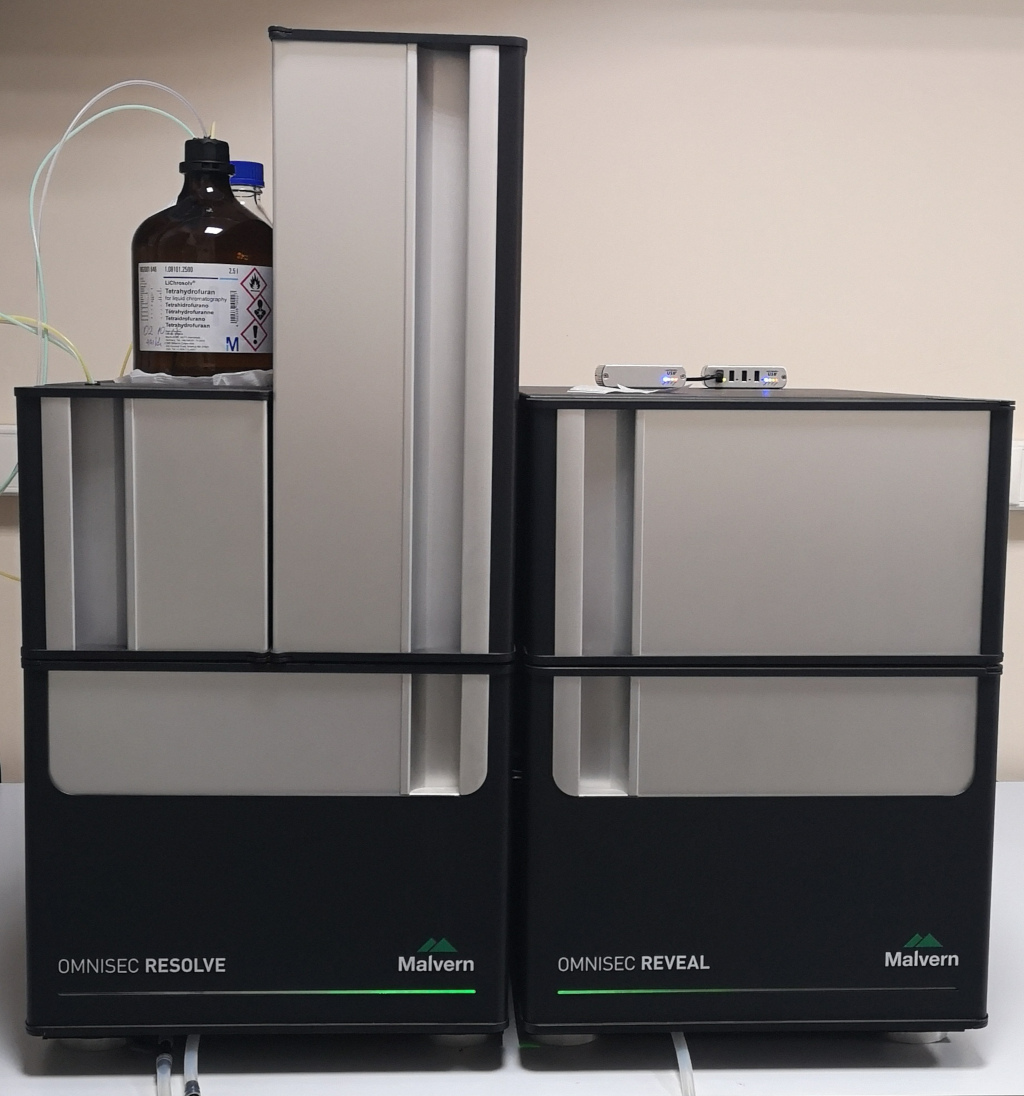Size Exclusion Chromatography

Gel Permeability Chromatography (GPC), also known as Size Exclusion Chromatography (SEC), is a chromatographic method that separates molecules based on particle size. This method is used to obtain fast and precise results in the determination of molecular weight and molecular weight distribution of polymers.
Instrument: Malvern – OmniSEC
The instrument consists of two parts, Resolve and Reveal.
In the Resolve part, there is a pump, degasser, sample stand and column furnace where the separation process takes place. The column furnace temperature was fixed at 35°C. There is a guard column and 2 Tx6000M columns.
THF (Tetra Hydrofuran) is used as a solvent. For example, it should be homogeneously dissolved in THF. Flow rate is 1mL/min.
Reveal includes three detector modules to characterize synthetic-natural polymers and proteins:
- Very sensitive light scattering detector: RALS (right angle light scattering) at 90o and LALS (low angle light scattering) at 7°, 640 nm Laser
- Viscometer detector: 4-capillary Wheatstone bridge (4 capillary Wheatstone bridges)
- Refractive index detector
The temperature of the module where the detectors are located is fixed at 35oC. Molecular weight can be measured in the range of 200-2x106 Da with Triple Detection.
When the types of substances for which the use of the light scattering detector is not suitable are studied, instead of the Triple detection method, the Universal Calibration (UC) method, in which RI and Viscometer detectors are used, is evaluated based on polystyrene. Molecular weight can be measured in the range of 1200-4.2x106 Da at UC.
Sampre Requirements
0.050 g of pure solid or liquid samples. The sample solvent should be THF.
Applications
Polymers, Macromolecules.

Gel Permeability Chromatography (GPC), also known as Size Exclusion Chromatography (SEC), is a chromatographic method that separates molecules based on particle size. This method is used to obtain fast and precise results in the determination of molecular weight and molecular weight distribution of polymers.
Instrument: Malvern – OmniSEC
The instrument consists of two parts, Resolve and Reveal.
In the Resolve part, there is a pump, degasser, sample stand and column furnace where the separation process takes place. The column furnace temperature was fixed at 35°C. There is a guard column and 2 Tx6000M columns.
THF (Tetra Hydrofuran) is used as a solvent. For example, it should be homogeneously dissolved in THF. Flow rate is 1mL/min.
Reveal includes three detector modules to characterize synthetic-natural polymers and proteins:
- Very sensitive light scattering detector: RALS (right angle light scattering) at 90o and LALS (low angle light scattering) at 7°, 640 nm Laser
- Viscometer detector: 4-capillary Wheatstone bridge (4 capillary Wheatstone bridges)
- Refractive index detector
The temperature of the module where the detectors are located is fixed at 35oC. Molecular weight can be measured in the range of 200-2x106 Da with Triple Detection.
When the types of substances for which the use of the light scattering detector is not suitable are studied, instead of the Triple detection method, the Universal Calibration (UC) method, in which RI and Viscometer detectors are used, is evaluated based on polystyrene. Molecular weight can be measured in the range of 1200-4.2x106 Da at UC.
Sampre Requirements
0.050 g of pure solid or liquid samples. The sample solvent should be THF.
Applications
Polymers, Macromolecules.
